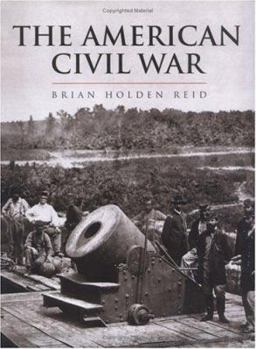The American Civil War and the Wars of the Industrial Revolution
(Part of the Cassell History of Warfare Series)
Select Format
Select Condition 
Book Overview
The Civil War was the bloodiest in America's history, comprising 149 engagements of importance and 2200 skirmishes. The author narrates the history of the war and also describes how such factors as... This description may be from another edition of this product.
Format:Hardcover
Language:English
ISBN:0304352306
ISBN13:9780304352302
Release Date:January 1999
Publisher:Cassell
Length:224 Pages
Weight:2.30 lbs.
Dimensions:1.0" x 8.1" x 10.8"
Customer Reviews
2 ratings
The Civil War and the evolution of modern warfare
Published by Thriftbooks.com User , 17 years ago
As the last reviewer noted, this book is about more than just the Civil War. As Brian Holden Reid states in the introduction, his goal is to place the Civil War in context with two other major conflicts of the mid-19th century, the Crimean War and the wars of German unification. Contrary to many traditional accounts of the warfare of the era, he sees the three as reflecting the evolution of large-scale industrialized warfare during those decades, with the different struggles nevertheless demonstrating commonalities in the impact of new technologies and the changing scale of war. This is evident beginning with the Crimean War. Fought in the shadow of the Napoleonic wars (the British commander had been Wellington's secretary), Reid nonetheless demonstrates, in a very British-centric account, that the expedition to the Crimea would have been impossible without the steam-powered ships which sustained the forces. Yet while he challenges the notion of the British military as being "a museum piece", he does note that the reforms introduced hardly addressed the challenges of the new warfare that commanders like Lord Raglan faced. Similar limitations emerged at the command level during the Civil War. Reid's analysis of the conflict dominates the book, taking up three of its five chapters. His analysis if primarily operational and strategic, and it reveals how unready - and in many cases, unadaptable - commanders on both sides were to the new scale of warfare. Grant emerges as the dominant commander, Reid argues, not because of his ability as a field commander (which he sees as inferior to Lee's), but because of his grasp of "what was important in the higher level of the conduct of war." In this Reid ranks Grant with Helmuth von Moltke as the first masters of industrialized warfare, as the Prussian general demonstrated similar attributes in his successful pursuit of victory against Denmark (which is only briefly addressed), Austria, and France. All of this Reid presents with a generous seasoning of his sharp observations which leave little doubt as to his opinion on matters (his assessment of the staff of Austrian general Ludwig Benedek is that they "made for an entertaining dining club" is one of the more amusing among many) and make for a lively text. By comparing the three wars, he demonstrates clearly how industrialization transformed warfare, while his operational narrative shows how slowly commanders adapted to these changes. Heavily illustrated with photographs and maps, it is a quick read, and serves as an excellent introduction to the Civil War while putting it in the context of the evolution of modern warfare.
Actually a work about Modern Industrial Wars
Published by Thriftbooks.com User , 24 years ago
Though the American Civil War is given top billing and forms the bulk of the book, it is one of three conflicts. First is discussed the Crimean War, which shows how little military science had advanced from the end of the Napoleonic era to 1854. The American Civil war is discussed in an admirable and brief fashion - important political concerns, emancipation proclomation, election of 1864, etc. are all mentionned. The power of the rifled musket, the defensive protection of field works, and the advantage of the tactical defensive are all noted. Land strategy is primarily emphasized, and the iron clad is mentionned only in passing. Yet it would be the grandfather of the great naval arm races to come. Civil War buffs will want more depth or be aware of topics skimmed over.Holden Reid gives proper credit to the amateur Americans in waging the first large scale continental wars using modern technology. While Napoleon and Caesar commanded large armies over vast distances, until the Industrial Revolution, it was not possible to arm, train, mass, supply, maneuver, and to communicate simultaneously with hundreds of thousands of soldiers, all moving under one strategic plan. He notes that while Grant and Moltke were inferior battelfield commanders to Lee, Moltke was the first to have the leeway of combining peace time preparation with actual war time plans. Grant is given more credit to his logistical planning.A well produced book with good illustrations, maps, and pictures. Particularly for the American reader, it offers a brief but well written discussion of the Austro-Prussian War of 1866 and the Franco-Prussian War of 1870-1871.In brief: a good survey of the first "modern wars." Fans of the American Civil War will find dedicated works to be of more interest. For those interested in development of military thought and practice the contrast of the Crimean War, ACW, and the German Wars of Unification in one volume will be fascinating reading.






